by Winding Pathways | May 16, 2017 | (Sub)Urban Homesteading, Garden/Yard, Nature, Trees/Shrubs
We never spray our lawn at Winding Pathways. Occasionally, that yields an exciting discovery like what happened in early May.
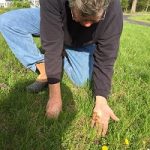
Rich shows the tiny oak seeding.
We wanted to plant a tree, preferably an oak, on the south side of our garage. But, we got busy and never found time to buy or plant one. One morning Rich, while walking across the lawn to fetch the morning newspaper, spotted a baby white oak tree that sprouted exactly where we wanted to plant one. It was serendipity.
Seed Banks”
Plant ecologists talk about the “seed bank.” In land that hasn’t been greatly disturbed by plowing, spraying or compacting of soil, seeds of desirable native plants often remain dormant in the soil for years or decades. Then, when conditions are right they’ll sprout like magic. Other desirable plants spread their seed through the wind or enlist the help of a hungry squirrel to carry and bury a nut or acorn. That’s probably how our new oak got planted.
Before mowing walk across your unsprayed lawn. You may discover a plant you want that is starting to grow. Just mow around it to let it thrive. Mark it with a stake or fence it off from rabbits and deer. If the plant is not quite in the right place, remember that tiny plants are usually easy to move with just a shovel full of dirt.
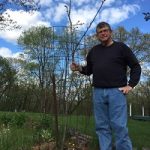
We protect volunteer trees that grow where we want them.
About seven years ago we found another baby oak in our lawn. We protected it from mowing and ran a screen around it to keep hungry deer away. It’s now about seven feet tall and growing rapidly.
That black oak didn’t cost a penny and will grace our yard long after we’re gone.
Another way to go about natural or plant and wildlife friendly yards is to deliberately plant certain forbs and grasses to attract a variety of beneficial insects and interesting birds and other wildlife.
by Winding Pathways | May 10, 2017 | Birds, Flowers/Grasses, Nature, Travel/Columns
May is about the most exciting month to travel and camp out in Iowa. We took in the Driftless area of Iowa and Wisconsin where we learned more about mounds at Effigy Mounds National Monument, ate at funky Café McGregor, took in Starks and Cabelas in Prairie du Chien, and entered our favorite forest over the “Forest Road” into Yellow River State Forest.
- Note our reviews and thoughts are independent, unpaid and unsolicited.
Enjoy this photo journal of our stay.
-
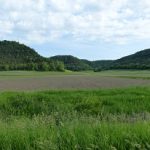
-
Fascinating terrain and vegetation characterize the Driftless Area.
-
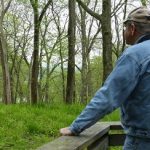
-
More questions than answers arise when investigating mounds.
-

-
Looking Down River
-
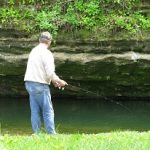
-
A great fishing spot.
-
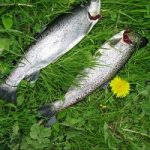
-
Fresh fish for dinner.
-
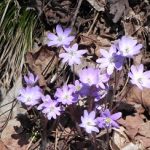
-
Spring is about a week later in northeast Iowa than central Iowa.
-
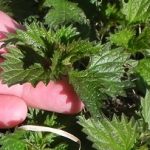
-
Nettles were a resource for Native Americans and still are for modern day foragers.
-
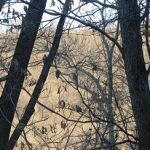
-
Last year’s young hang around as long as they can.
-
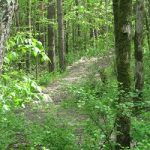
-
A favorite walk.
-

-
Season Five now open!
-
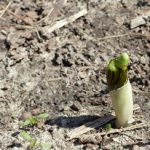
-
Tightly wrapped Mayapple pushes through the early spring ground.
-
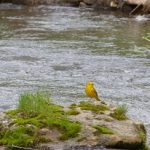
-
Birding is exceptional in May.
by Winding Pathways | May 9, 2017 | Flowers/Grasses, Nature, Trees/Shrubs, Wonderment
We invited readers of Winding Pathways blogs to submit a photo and short description of a favorite spring scene. The response spanned from the Pacific Northwest to Canada and from the Desert Southwest to New England. Enjoy readers’ reflections on our emerging spring. The essays appear as they came in to Winding Pathways. Thank you all for your charming observations. Happy Spring! And soon, welcome summer.
***

“Every year I wait for our Sargentina crab apple trees to bloom.”
As much as I love our native prairie plants and various garden inhabitants, every year I wait for our Sargentina crab apple trees to bloom. Not too long ago, in the company of one of our barn cats, I sat out on the patio and watched the full moon rise with the sweet smell of the flowers drifting over. Bees lay full claim to the blossoms during the day, from the little sweat bees to the bumbles, so I try to give them some space and wait until evening before diving nose-first into the branches myself.
Emily Groom Hemmerling, Kansas
***
Here in NH, spring is slowly unfolding. The barred owls are getting amorous and I’ve heard, although not seen, “our” hawks. There’s a barn swallow that’s building a nest under the eaves, and the bear visited the other night. The weather seems to be lacking any nuance. We are alternating between two or three days of cold, windy, rainy (tell the truth–nasty) days and occasional beautiful sunny days in the ’70s.
Waiting is hard after a long winter, but change should accelerate very soon. The hummingbirds return on average on May 11th, and by then many flowers should be in bloom and the trees that are barely budding today will be fully green. This time of year Carly Simon is often on my mind–“Anticipation”. Sue Fehsinger, New Hampshire
-
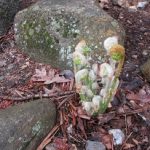
-
Unwinding slowly, fiddle head ferns appear mysteriously.
-
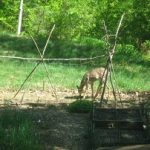
-
Deer In Garden
-
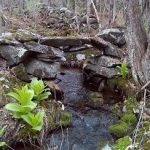
-
A New Hampshire springtime brook graced with Skunk Cabbage.
-

-
A splash of color!
***

Dazzling white petal surround deep yellow centers.
These Bloodroots are found at the western end of our road. We have now lived on this road for 17 years and have watched the progression of growth and expansion each year of more and more desirable plants. The area has become a huge carpet of white under all the trees. The blossoms on the north side of the road show their faces first and a few days later the blossoms on the south side of the road appear. Since we have been here, each year it has been the same blooming schedule. We also have Bloodroots in our yard which don’t appear until the ones on the road seem to be in full bloom. They are only 1/4 mile apart.
I photographed this forsythia at the edge of our neighbor’s property. I do not have any on our property. It was a beautiful sunny day and the yellow of the blossoms was brilliant. I was also trying to get a different angle on the blossoms, rather than the whole bush.
My purple hyacinths are still producing blooms in my small north facing garden. This year they seemed to have a deeper purple color and more blossoms on the stock.
The Virginia bluebells are now blossoming. I counted 16 clumps of them in a small area at the top of our dry kettle. I am even finding small self-seeded plants.
We are privileged to see wood ducks in our channel in the early spring. They are very skittish and it is difficult to sneak up on them to get a photo. We see them for a short time and then they disappear until next year. Sue Hrobar, Wisconsin
-
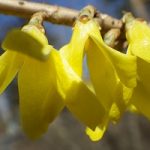
-
Like gold the flowers shine.
-

-
Beautiful Purple Blossoms
-
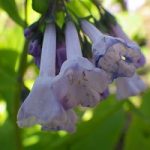
-
Close-up view
-
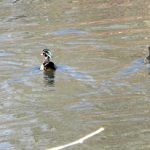
-
Searching for the right home.
***

The ancient tree sprouted leaves and flowers all over.
I walked this Chestnut Hill neighborhood in Boston often while living and working in the area. My first fall a few heavily gnarled trunks of a handful of trees planted in the boulevard strips particularly captivated me. These trunks reminded me of Italian grandmothers; stout, sturdy, not particularly tall, deeply wrinkled and absolutely beautiful. When spring arrived I was amazed to see how blossoms not only appeared in their canopies but also sprang from their very bark. I loved these elderly trees all the more and saw them as clothed from head to toe in spring attire. May all of us exhibit such beauty and grace as we mature. Adria J, Illinois and Maine
***
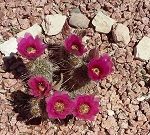
The desert Southwest alive with color.
Here is my first cactus bloom of the season! Soon my yard will be bursting with color, from all of the different cacti!
Coming from the Midwest, this is such a different sort of pretty. Most of the year it is dry and barren up here in the high desert. These little bursts of color that pop up in the spring are such a delight! I love to walk in my neighborhood and see all of the different blooms. We have a very mild winter and sometimes it’s hard to tell that spring is here, at least for this Midwestern gal. The flowers alert me that spring has indeed arrived! Such a contrast to these prickly little fellows. Add to that the brilliant green of the trees, looking almost iridescent, and the scent of the roses that pop up everywhere, I would say that spring is my
favorite season here. Deb Karpek, Arizona
***

A close up of a western Rhododendron.
After the daffodils and the flowering trees fade is time in the Pacific Northwest for our native rhododendron to flower. They grow wild on the coast, but also are prized in yards because their large leaves are green all winter. Found growing wild near Port Discovery on the Washington coast in 1792 by Archibald Menzies who was with George Vancouver, it has been a favorite ever since. Officially it has been the Washington state flower since 1995, but women in 1893 designated it as such for a Worlds Fair that year. The rhododendron pictured is the Washington Centennial rhododendron from 1989. I love the way the blooms start out bright pink and fade to a pale pink as they open.
Jocelyn Berriochoa, Washington state
***

Raindrops on lilacs.
I opened the door this morning and looked out to see our lilacs blooming; pretty as could be. I thought, “Thank you, Grandma, for planting them over seventy plus years ago.” What a special way to start the day and welcome some of the beauty of spring. Claire Patterson, New Jersey
***
Spring came early to Bedford, Virginia, this year by about three weeks which means farmers, orchardists and gardeners began planting and hoping for early crops. Then to their surprise, we had two serious freezes back-to-back in March. The orchardists were especially chagrined because peaches, pears and apples took a hit. Watch for rising fruit prices.
As a gardener, it was thrilling to clean out the flowers and raised vegetable beds early on. As I began checking the asparagus patch, I noticed two silvery milkweed spears poking their heads through the soil next to the asparagus. They had begun their quiet vigil for the returning Monarch butterflies. I know the Monarchs have reached their most northern breeding grounds. However, I’ve not seen one returning Monarch here at the Ridge House.
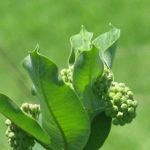
Milkweed is an important plant for Monarchs and other pollinators.
How did the milkweed come to be in my asparagus bed? There are a number of possibilities. Perhaps the birds deposited the seeds long ago. Or, the wind may have blown these wispy silky pinwheels into the patch. Another thought occurred to me that the seeds may have been tangled in the straw I scattered in the patch to help hold moisture through the dry summer months. However the seeds arrived, they are a God send as unthinking highway department mowers clear the roadsides, or a farmer applies toxic weed killer, or a home owner wanting a pristine lawn shears them off. The end result is far fewer pollinators like Monarchs and other butterflies, bees, and even birds. Where am I going with this you ask? This sage says, “All my weeds are wildflowers.” Peace. Jackie Hull, Virginia
***
-

-
Spring in NYC
-

-
New York City is awash with soft color in the spring.
Spring in New York City. Dan Patterson, New York
***
Snow is melting gradually this spring. And, despite the string of rainy days lately, at the end of April we still had mounds of it around the house and in the woods.
The slow melt has meant that I’ve kept up with yard cleanup and, while trimming around the edge of the yard, I have come across early gems, like the bright purple crocuses with their eye-popping yellow-orange stamen, nestled among moss covered rocks near the path into the woods.
Elsewhere, along the edge of the woods, the early Spring ground cover, known as ‘William & Mary’, is starting to show its pink and blue blossoms. (I think of my patch as ‘Will & Kate’.)
And, I uncovered the little pile of beach stones that granddaughter Cadence assembled one summer.
Every Spring is different and every day brings different discoveries and possibilities in the garden.
Now, I’m headed out and about to see what new stuff is uncovered before the heavy rains come. I’m thankful we live outside the flood zone, but Fredericton will see another 100 year flood this weekend I fear. Lucy Fellows, New Brunswick, Canada
-
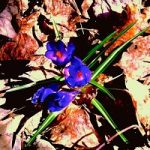
-
Poking through the leaves is a burst of color.
-
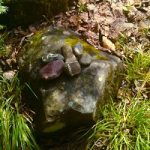
-
A stack of pebbles.
-
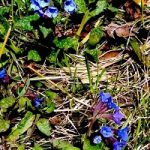
-
Early spring arrival
by Winding Pathways | Apr 25, 2017 | Flowers/Grasses, Nature, Wonderment

Tightly wrapped Mayapple pushes through the early spring ground.
Early each spring we look forward to the appearance of hundreds of Mayapples in our small woods. They appear like magic, usually after a few warm April days. Only a couple of days after their first shoots poke through the ground our woods are carpeted with umbrella-like Mayapple leaves.
It’s too bad that the Mayapple is misnamed. In most parts of its range, from Florida to Quebec and west to the Great Plains, it starts growing in early spring, flowers in May, and produces “apples” in June or early July. So, perhaps it should be called Mayflower or Juneapple.

Mayapples populate open slopes.
Mayapples love living in the dappled sunlight in open forests. They spread by rhizomes and occasionally creep out into sunny areas and into deeper, darker woods. One of the delights of this plant is how easy it is to identify. No other North American wildflower sports the large umbrella like leaves that often appear in large patches.
When we look closely at our Mayapple patch we notice that most are leafy umbrellas rising on a single stalk while some are forked with a stem that splits like a “Y” and sporting two umbrellas.
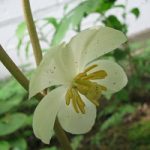
Beautiful blossoms hide under the umbrella-like leaves.
In May, these double leafed stems each grow one gorgeous but easy to miss white flower that’s usually pollinated by bumblebees. The flowers are easy to miss, because they are shaded by the large leaves.
The flower grows into a green fruit that looks like a mini lemon. It gradually turns yellow as it ripens.
All parts of this plant are toxic including the green fruit. However, once the fruit turns yellow it becomes edible and may people enjoy its custard-like fruit. But, be cautious. If eating it for the first time just enjoy a tiny portion of the yellow fruit to make sure it agrees with your system. Always be certain your identification is correct. A reliable source of information on many plant species, including Mayapple is United States Department of Agriculture, Natural Resources Conservation Service. Enter the name of the plant being sought, using either common or scientific name.

Mayapples spread by rhizomes.
Mayapples create a beautiful ground cover in open woods. They are easy to establish. Dig a few roots from a large patch and plant them under the trees. They’ll spread by rhizome.
by Winding Pathways | Apr 22, 2017 | Birds, Flowers/Grasses, Nature, Trees/Shrubs, Wonderment

Beautiful blossoms hide under the umbrella-like leaves.
First submission in! Hey all, on Facebook Winding Pathways invited folks to submit a favorite spring photo – tree, scene, flower, animal – with a short write-up of why you like that picture. And, Kansas readers Emily and Zach Hemmerling have already replied! Way to Go!
Now, I’d love to have about a dozen more so send them in to our email and I’ll continue processing and then post. These samples of spring pictures. Join in the fun and share your descriptions!
-
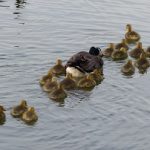
-
Photo – Protective custody
-
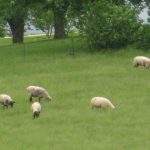
-
Photo of sheep in pasture
-
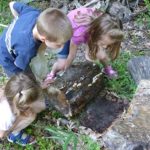
-
Kids develop strength, cooperation, and curiosity as they explore outside.
-
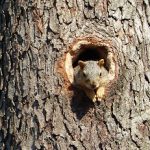
-
It’s a long way down, Mom.
-
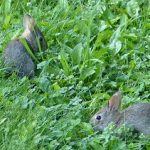
-
Bunnies are on their own as soon as the mother weens them.
-
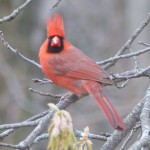
-
Photo – On a wild and windy day this Cardinal sang out his love song.
-
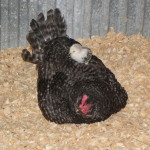
-
This mama hen with chick on her back fluffs up clean wood chips.
-
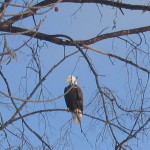
-
Eagle watching over nest.
-
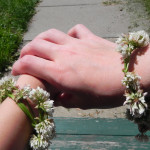
-
Clover bracelets
by Winding Pathways | Apr 18, 2017 | (Sub)Urban Homesteading, Birds, Nature
At Winding Pathways, we venture into our yard nearly every day, even if it’s raining, windy,
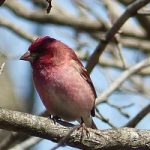
Some birds homestead at Winding Pathways.
or frigid out. Of all the times, early May is our favorite to linger outdoors. Why? It’s the best birding.
Very late April and the first couple of weeks of May boast normally glorious weather, blooming flowers and birds. Lots of birds, including those we can only enjoy for a fleeting week or two.
Here’s how we group the birds that we enjoy in our yard. Odds are the same or similar species follow this pattern in backyards with good habitat across much of the continent.
THE HOMEBODIES
Some birds don’t migrate. They brave the cold and grace winter feeders. In summer, they often raise broods of babies on the edge of the yard. These include titmice, chickadees, cardinals, nuthatches, house sparrows, and many woodpeckers.
THE NORTHERNER
Juncos are almost always under our feeders all winter gleaning seeds. To a Junco Iowa is the balmy south with a “warm” winter. Around mid-April they head north to nest in the boreal forests of Canada and Minnesota. We won’t see them again until around Halloween.
THE LOCALS
Many people consider the first sighting of a Robin to be a sign of spring. They assume the birds just arrived from the south. Robins, and closely related bluebirds, aren’t ambitious migrants. As the weather cools each fall, they abandon suburbia and move to nearby brushy areas for the winter. Winter Robins are common in orchards, the edges of farm fields, and wherever they can find dry and frozen fruit. These much-admired birds do a dietary switcheroo each year. Robins are famed worm eaters, and during warm months, they mostly eat insects and other invertebrates. In winter, they’re mostly vegetarians and dine on frozen berries. In years when fruit is scarce they’ll move south until they find suitable foraging.
THE HOMESTEADERS
Many birds are true migrants that winter far to the south but return north to raise a family. Among these true migrants are house wrens, rose breasted grosbeaks, orioles and indigo buntings. The homesteaders that nest at Winding Pathways have reached their northernmost destination but many of the same species simply rest and eat for a day or two before flying further north to nest. They are mere passersby.
THE AMBITIOUS MIGRANTS
Many birds are serious migrants that winter in South or Central America or the southern US and wing north to Canada and even Alaska to nest, only stopping to rest and eat for a day or two on their long journey. Many are warblers, although dozens of other bird species only use Winding Pathways as their “quick stop” on the way north. We can only enjoy the procession for a week or two in early May as the migrants stock up and then catch the next southerly winds to propel them to their nesting areas.
BIRDING AT ITS BEST
What’s remarkable about early May is the sheer diversity of birds that visit yards. It’s the best time to bring a cup of coffee and pair of binoculars outside. Sit quietly and look and listen to discover the amazing array of birds not possible observe in other seasons. A good bird book helps with identification but we often use the resources of the Cornell University Laboratory of Ornithology to help us identify and learn about birds. Their website at includes outstanding information that helps us determine species by both sight and sound and we frequently use their MERLIN phone app when we’re hiking or camping.















































